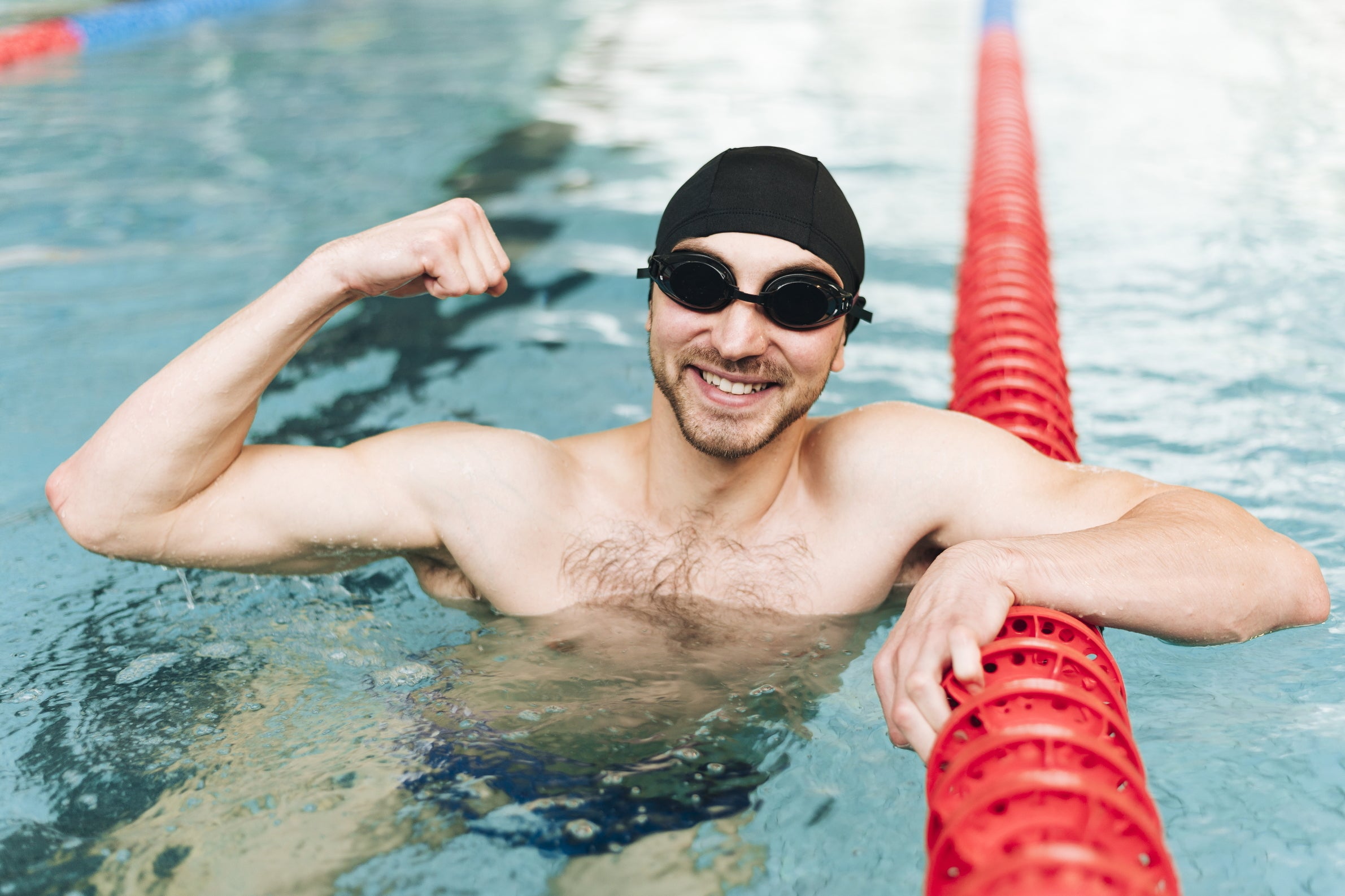Viele Triathlon-Einsteiger tun sich vor allem mit der ersten Wettkampfdisziplin - dem Schwimmen - schwer. Der Einstieg in das korrekte Techniktraining ist aber gar nicht so schwierig. Um das zu zeigen, hat euch unsere Schwimm-Expertin Annette Gasper in diesem Artikel zehn Tipps zusammengetragen, mit denen ihr auch als Anfänger eine gute Kraultechnik bekommt.
Wichtig ist dabei allerdings, dass ihr nicht versucht alle Punkte gleichzeitig zu berücksichtigen, sondern euch immer voll auf eine Übung konzentriert, um diese dafür auch perfekt auszuführen.
Tipp 1 - Wasserlage
Im Wasser gilt: je flacher man im Wasser liegt, desto besser. Dadurch wird der Wasserwiderstand verringert und die Fortbewegung ist deutlich kraftsparender.
Übung: Stoßt euch von der Beckenwand ab und versucht so lange wie möglich nur zu gleiten. Je stromlinienförmiger ihr dabei im Wasser liegt, desto weiter werdet ihr kommen.
Tipp 2 - Kopfposition
Die richtige Wasserlage wird sehr stark von der Kopfhaltung beeinflusst. Schaut ihr konstant nach vorn, sinken die Beine hinten ab. Richtet euren Blick stattdessen auf den Beckenboden, nur leicht nach vorn gerichtet. Damit habt ihr die beste Wasserlage. Der mangelnde Blick nach vorn ist im Becken kein Problem, da ihr die Leitlinien am Beckenboden zur Orientierung nutzen könnt und ca. 2m Blickfeld nach vorne ausreichen, um Zusammenstöße zu verhindern.
Tipp 3 - Augen schließen
Auch hier geht es wieder um die Wasserlage. Schwimmt auf einer möglichst freien Bahn probeweise mit geschlossenen Augen, ohne immer wieder den Kopf zu heben um zu sehen was vor euch liegt. Dadurch vergrößert ihr die Zeit in der flacheren Schwimmhaltung und trainiert gleichzeitig die Orientierung im Freiwasser.
Tipp 4 - Atmung
Dass man über Wasser ein- und unter Wasser ausatmet klingt logisch. Beim Kraulen geht es aber besonders darum, das Ausatmen auch wirklich unter Wasser durchzuführen und abzuschließen. Haltet ihr die Luft an und atmet erst aus, wenn ihr den Kopf aus dem Wasser hebt, bleibt euch weniger Zeit um genug Luft einzuatmen.
Übung: Stellt euch ins Wasser und simuliert die Atmung beim Kraulen.
Zugehörige Kategorien
Tipp 5 - Flach atmen
Das durchschnittliche Lungenvolumen beträgt ca. 4 Liter. Mit einem Atemzug an Land befördern wir ungefähr 0,8 Liter in die Lunge, was auch für das Kraulschwimmen genügt. Achtet darauf nicht zu hektisch und schnell zu atmen, da eine flache Atmung viel Ruhe in euer Schwimmtraining bringen kann.
Tipp 6 - Nehmt Schwung mit
Obwohl es erstmal nach Schummeln klingt: Stoßt euch ruhig vom Beckenrand ab und beginnt direkt mit einem lockeren Beinschlag. Auch wenn ihr im See keine Wand zum Abstoßen habt, verbessert es euer Wassergefühl, was für den Wettkampf von Vorteil ist.
Tipp 7 - Schwimmen ohne Atmung
Manchmal fällt es schwer sich auf alle Dinge gleichzeitig zu konzentrieren. Probiert daher nach dem Abstoßen ein paar Züge ohne Atmung zu schwimmen. Konzentriert euch dabei voll auf eure Technik und macht zum Luft holen eine kurze Pause.
Tipp 8 - Beinschlag
Klar, die Beine braucht ihr in den anderen beiden Disziplinen auch. Ein lockerer Beinschlag kostet aber nur wenig Energie und verbessert die Wasserlage deutlich.
Übung: Versucht in tiefem Wasser vertikal zu schweben und den Kopf über Wasser zu halten. Diese Beinschlag-Intensität reicht auch im Wettkampf um die Wasserlage zu verbessern.
Tipp 9 - Zählt eure Züge
Wenn ihr noch nie gezählt habt, wie viele Armzüge ihr auf 50 Meter benötigt, solltet ihr das im nächsten Training tun. Etwa 20 Züge auf einer 25m Bahn sind ein guter Richtwert (50m Bahn ca. 40-45 Züge). Benötigt ihr deutlich mehr, versucht euren Arm länger liegen und gleiten zu lassen.
Übung: Schwimmt 8 x 50 Meter und macht jedes Mal einen Armschlag weniger.
Tipp 10 - Ausgleich schaffen
Egal, wie gut ihr schwimmt, nach zu langer Belastung, verschlechtert sich eure Technik. Baut deswegen immer wieder zwei Bahnen Brustschwimmen (da die Atmung dort leichter fällt) oder Rückenschwimmen (Atmung immer möglich) in das Training ein. Durch die Abwechslung regeneriert ihr schneller und könnt früher wieder effektiv an eurer Kraultechnik arbeiten.
Zum Schluss: Macht euch keine Sorgen, wenn am Anfang noch nicht alles klappt. Durch Wiederholung der Übungen stellt sich zunehmend der Lerneffekt ein. Konzentriert euch dabei jedoch immer auf eine Übung. Wichtig ist: um konstante Fortschritte zu machen, müsst ihr mindestens zweimal, besser aber dreimal pro Woche ins Wasser.





















1 Kommentar
Alfons
Vielen Dank für die Tipps!
Das ermutigt sehr für ein gezieltes Training. :-)